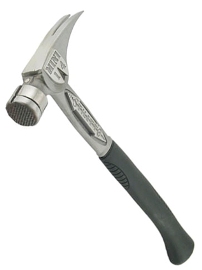|
Titanium hammer – the hitting face of the glamour metal.
 The Russians were the first to adapt titanium for tooling industry, mainly because they were looking for an increase in industrial productivity back in the Cold Ward days when they were eager to surpass those damned ideology backwards capitalists, especially in the economic domain. Nice try.
Of course, the decision was helped by the fact they had one of the greatest titanium supply in the world – they still do, and by the power of hammer as a symbol in Soviet culture of that time, the hammer and the sickle being the main components of the soviet coat of arms.
The use of titanium in tooling industry in general is validated by its reliability, toughness and strength, with the corrosion resistance added as an important supplemental bonus.
The titanium hammer in special, favors the efficient strength to weight ratio of the metal.
The Russians were the first to adapt titanium for tooling industry, mainly because they were looking for an increase in industrial productivity back in the Cold Ward days when they were eager to surpass those damned ideology backwards capitalists, especially in the economic domain. Nice try.
Of course, the decision was helped by the fact they had one of the greatest titanium supply in the world – they still do, and by the power of hammer as a symbol in Soviet culture of that time, the hammer and the sickle being the main components of the soviet coat of arms.
The use of titanium in tooling industry in general is validated by its reliability, toughness and strength, with the corrosion resistance added as an important supplemental bonus.
The titanium hammer in special, favors the efficient strength to weight ratio of the metal.
Just imagine the common actual movements involved in the action of hammering. Let’s be more explicit. While firmly grasping the hammer in hand, the arm of the worker is moving in a back and forth swinging motion. The potential energy accumulated during this movement, increased by the actual physical effort, is transferred onto the object that is being hammered. There are two aspects that are critical for an efficient hammer use. Gathering the energy in phase one requires an effort directly related to the weight of the hammer head. The lighter the hammer head, the lesser the effort involved, thus better productivity, and more nails that can be put trough the beam. Titanium hammer heads, though being light, still have the required toughness necessary not take the damaging effects of the energy release themselves. The other critical aspect is the transfer ratio of the accumulated energy into the hammered object. This is never a 100% efficient process. The remainder of the energy is dissipated in the hammer head and then in the workers hand and arm. There are several work related diseases that are caused by exactly this aspect of the hammering operation. The risks are substantially lowered when using a titanium head hammer, because it has the greatest transfer ratio, as much as 97%, compared with its competitors, the most common being steel with something around 70%. These are the most important you must know about titanium hammers. It is equally important to know that if you don’t use a hammer extensively you’re not likely to notice – and you should not care about, either – the aspects outlined above. And you don’t have to pay the hefty price tag – going from 100 to 250 $, depending on the hammer - associated with all of the titanium products. If you just want to put that family photo on the wall, a common steel hammer is all right. Heck, a rock is also perfectly all right, for all its worth. But for a professional that nails down hundreds per day, a titanium head hammer may provide the critical difference. To close it, just keep in mind that you’re going to hurt a lot less if you drop a titanium hammer on your fingers. Return from Titanium hammer to Titanium industry Return to Titanium Home Page
|


